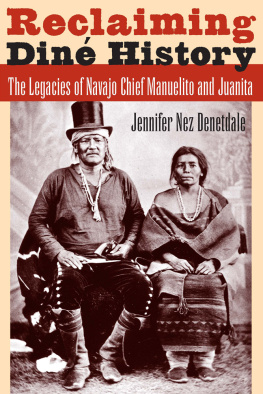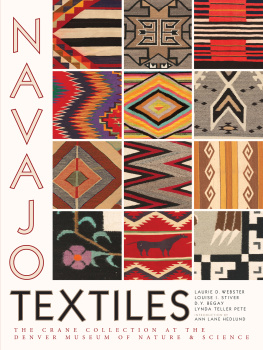Din
Din
A HISTORY OF THE NAVAJOS
Peter Iverson
Featuring photographs by Monty Roessel

To Kaaren
To Karina, Jaclyn, Bryan, Robert, and Robyn
And to the future of the Navajo Nation
ISBN for this digital edition: 978-0-8263-2716-1
2002 by the University of New Mexico Press
All rights reserved.
First edition
Paperbound ISBN-13: 0-8263-2715-4
19 18 17 16 15 14 8 9 10 11 12 13
The Library of Congress has cataloged the printed edition as follows:
Iverson, Peter.
Din : a history of the Navajos / text by Peter Iverson ;
photographs by Monty Roessel.1st ed.
p. cm.
Includes bibliographical references and index.
ISBN 0-8263-2714-1 (cloth : alk. paper) ISBN 0-8263-2715-x
(pbk. :alk. paper)
1. Navajo IndiansHistory. I. Roessel, Monty. II. Title.
E99.N3 I88 2002
979.1004972dc21
2002006407
Contents
List of Illustrations & Maps
Acknowledgments
In the spring of 1969, I applied for a teaching position at Navajo Community College, a new institution established by the Navajo Nation. The college hired someone else, who then backed out of the assignment right before classes began that fall. Navajo Community College needed to find a person young and foolish enough to take on this assignment at the last possible minute. I hardly hesitated before I agreed to come to Many Farms.
The years I spent at the college changed the course of my life. They fundamentally influenced my perspective on Native history in general and Navajo history in particular. Living and working in Din Bikyah helped me understand the importance of the land, the ways in which the Navajos incorporate new elements, and the significance of historic events. This time furnished a foundation. Through the decades, many Din teachers have taught me. It has been an honor and a pleasure to work with Monty Roessel to produce Din: A History of the Navajos and For Our Navajo People: Din Letters, Speeches, and Petitions, 19001960.
My interest in Navajo history did not begin in 1969. Rather, it started during my childhood, when I began to see photographs and hear the stories from my grandparents time in Navajo country. During the 1930s and early 1940s, my grandfather served as a principal in Indian Service schools at Fort Wingate, Keams Canyon, and Toadlena. One of my mothers sisters was married at St. Michaels; another sister employed her camera to capture lasting images of a transitional time. My mother made a number of trips to visit her parents in Din Bikyah. In an age when people still wrote letters, they wrote all the timeand they saved their correspondence.
Perhaps because my grandparents never drank anything stronger than coffee, went to mass all the time, ate the vegetables they grew in their own garden, and voted Democratic, they lived into their nineties. During my first autumn in Navajo country, I drove over to southern California to see them. They informed me that my colleagues, silversmith Kenneth Begay and linguist William Morgan, had been students at Fort Wingate during the time my grandfather served as its principal. I returned to Many Farms armed with the Wingate yearbook and more stories.
Even now I still meet people who remember my grandparents. I think of my relatives each time I return to the Navajo Nation. I am glad to have the opportunity to thank them once again for sparking my interest in this remarkable community. I also would like to thank my father, who died in 1994, and my mother, who continues to instruct me, for helping me to appreciate the importance of history, memory, stories, and place. As always, I want to express my gratitude to Kaaren, whose love, patience, strength, and grace make better each of my days. To Erika, Jens, Anna, Scott, Lissa, Tim, and Laurie, my appreciation for your interest in and support of this book and for all that you have taught and given me. To David, Paul, Yoko, Alice, Vi, Joe, Diane, Dick, Becky, David, Terry, and Mark, my thanks for your love, understanding, and encouragement.
Din: A History of the Navajos and For Our Navajo People: Din Letters, Speeches, and Petitions, 19001960 have been informed and inspired by many Din teachers. I cannot name them all, but I want to begin by thanking Monty Roessel for this collaboration and for his friendship. Thanks, too, to Francis Becenti, Clifford Beck, Kenneth Begay, AnCita Benally, Bahe Billy, Jennifer Nez Denetdale, Anthony Chee Emerson, Larry Emerson, Ned Hatathli, Dean Jackson, Jack Jackson, Rex Lee Jim, Jennie Joe, Priscilla Kanaswood, Carol Lujan, B. Kay Manuelito, Richard Mike, William Morgan, Mabel Myers, Betty Reid, Ruth Roessel, Luci Tapahonso, Francis Teller, Carl Todacheene, Glojean Todacheene, Laura Tohe, Harry Walters, and Peterson Zah, for all that you have shared with me.
David Aberle, John Adair, William Adams, Carol Behl, Hank Blair, David Brugge, Bruce Burnham, Kathleen Chamberlain, Lee Correll, Wade Davies, Bill Donovan, Charlotte Frisbie, Steve and Gail Getzwiller, Bruce Gjeltema, Ann Hedlund, Klara Kelley, Larry Kelly, Bill Malone, Laura Moore, William Moore, Bob McPherson, Don Parman, Steve Pavlik, Bill Quinn, Marian Rodee, Bob Roessel, Scott Russell, Orit Tamir, Mark Trahant, Scott Travis, Tara Travis, Bob Trennert, Mark Winter, Marsha Weisiger, David Wilkins, Robert Young, Paul Zolbrod, and others too numerous to mention have aided my understanding of Navajo history and culture.
I want to express my appreciation to AnCita Benally, David Brugge, Margaret Connell-Szasz, Jennifer Nez Denetdale, Charlotte Frisbie, Adelaide Iverson, David Iverson, Erika Iverson, Jens Iverson, Kaaren Iverson, Scott Travis, and Tara Travis for their careful and perceptive reading. Thanks to AnCita Benally for providing the appropriate diacritical markings for Navajo words. I thank editor Beth Hadas, director Luther Wilson, and associate director David Holtby of the University of New Mexico Press, who embraced this endeavor right from the start and helped shepherd these books to prompt publication. Thanks, too, to production manager Dawn Hall, supervisory editor Amy Elder, designer Melissa Tandysh, and copyeditor Barbara Kohl for their support and assistance. My thanks as well to Pat Etter and Chris Marin of Arizona State University, Evelyn Cooper of the Arizona Historical Foundation, Rose Diaz and Mary Alice Tsosie of the University of New Mexico, Lisa Gezelter and Paul Wormser of the National Archives in Laguna Niguel, Joel Barker of the National Archives in Denver, John Ferrell of the National Archives in Seattle, Laine Sutherland of Northern Arizona University, Jim Dildane of Arizona Historical Society in Flagstaff, and George Miles of Yale University for their assistance. I would like to express my gratitude to Arizona State University, Northern Arizona University, the University of Arizona, the Museum of Northern Arizona, Yale University, Hubbell Trading Post and the National Park Service, and the National Archives in Laguna Niguel, Denver, Seattle, and Washington, D.C., for materials reprinted in For Our Navajo People.
Fellowships from the John Simon Guggenheim Memorial Foundation and the National Endowment for the Humanities helped support research and expedited the completion of these volumes. Arizona State University supported this project in many ways, including a sabbatical leave. My department chair, Noel Stowe, offered consistent encouragement and assistance. Colleagues Roger Adelson, Angela Cavender Wilson, Rachel Fuchs, Susan Gray, Kyle Longley, Beth Luey, Carol Lujan, Steve MacKinnon, Susan Miller, James Riding In, Jim Rush, Kay Sands, Laura Tohe, Bob Trennert, Phil VanderMeer, Myla Vicenti Carpio, and Matt Whitaker expressed interest in and offered support for this project. Research assistants Laurie Arnold and Jane Lawrence furnished invaluable help. Undergraduate students in my introduction to Navajo history classes proved enthusiastic in their consideration of primary source materials.
Next page





